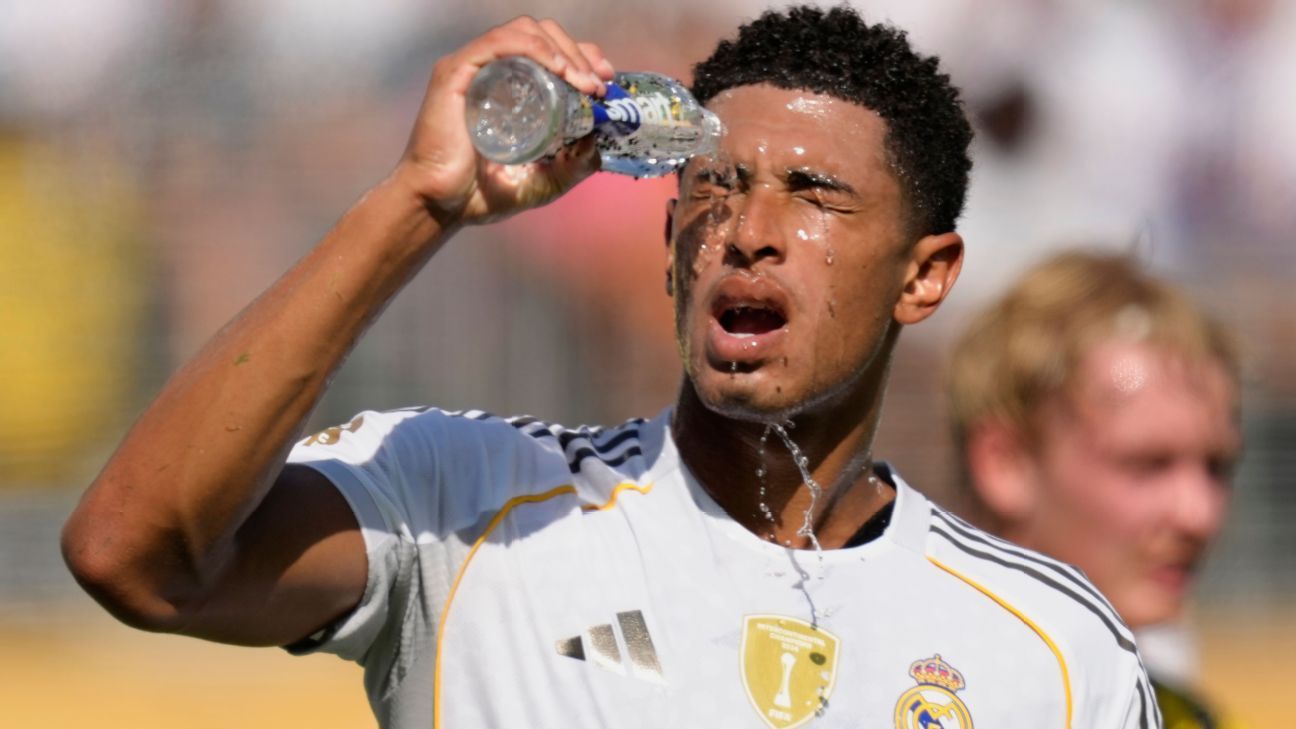NEW YORK – With less than a year to go before the US co-hosts the tournament alongside Mexico and Canada, concerns have already emerged regarding the high heat and humidity that teams faced during the Club World Cup. The conditions could lead to significant challenges for players during the summer tournament scheduled to take place from June 11 to July 19 next year.
Prominent players, coaches, leaders from the global players’ union FIFPRO, and climate specialists have raised alarms about the potential dangers linked to the upcoming 48-team World Cup, particularly in the sweltering summer heat.
The 2022 Men’s World Cup in Qatar was moved to November and December to sidestep the extreme summer temperatures exceeding 100 degrees Fahrenheit. In light of this, FIFA is now re-evaluating next year’s World Cup plans to ensure that players’ safety is prioritized over commercial interests, especially in light of notoriously harsh temperatures.
“From a health and safety standpoint, it’s crucial to prioritize extreme heat concerns over profit,” stated Alexander Billefeld, FIFPRO’s director of policy and strategic relations, during a call discussing concerns about heat at the Club World Cup.
“Heat doesn’t occur in isolation, and discussions about it shouldn’t ignore its foreseeable impacts.”
“I wouldn’t play outside at 2 PM.”
How challenging is it to play soccer in scorching heat when most people wouldn’t even consider stepping outside for a walk?
The 1994 World Cup in the US recorded the hottest match ever when Mexico faced the Republic of Ireland, with temperatures exceeding 100 degrees Fahrenheit in Orlando. Some players even wore baseball caps to shield themselves from the sun during the national anthem.
“The conditions were horrific,” recalled former Irish and Manchester United defender Dennis Irwin, who noted that temperatures reached 117 degrees Fahrenheit at pitch level, making concentration extremely difficult.
“We anticipated the heat, even training in wetsuits to adapt, but nothing could prepare us for that experience. It was probably dangerous to compete under such conditions.”
Should players today be subjected to similar extremes when modern sports science offers better options?
According to FIFPRO, three matches during the Club World Cup, including Paris Saint-Germain vs Atletico Madrid in Pasadena, California, Chelsea vs Esperance in Philadelphia, and Benfica vs Bayern Munich in Charlotte, North Carolina, should have been postponed or suspended due to exceeding the wet bulb globe temperature (WBGT) threshold of 28 degrees Celsius (82.4 degrees Fahrenheit). This index measures thermal stress considering factors like temperature, humidity, and wind speed.
“Our position is that these matches should be rescheduled to a more favorable time or relocated. If no alternative is available, rescheduling is necessary,” advised Dr. Vincent Gouttebarge, FIFPRO Medical Director.
FIFA’s WBGT threshold is set at 32°C (89.6°F), which allows for one cooling/drink break during each half of a match, while Major League Soccer (MLS) enforces a lower threshold of 29°C (84.2°F). During the Club World Cup, FIFA applies a general rule permitting one cooling break in both halves, regardless of the WBGT value.
“I can honestly say I’ve never played in conditions like this,” Benfica forward Andreas Schjeldup said after facing Bayern Munich, when the WBGT reached 29.2°C (85°F). “I don’t feel healthy; I just managed to keep going.”
The first semi-final between Chelsea and Fulminence in New Jersey nearly reached the 28 (82.4°F) threshold, clocking in at a WBGT of 27.9 at the 3 PM kickoff. ESPN reached out to FIFA for comment on whether there are thresholds that could lead to game stoppages due to severe heat but received no response by the time of publication.
Based on temperature and humidity data, FIFPRO has highlighted six venues for the 2026 World Cup—Atlanta, Dallas, Houston, Kansas City, Missouri, Miami, and Monterrey, Mexico—that present a “very high risk” of heat stress for players.
Under such circumstances, players risk core temperatures exceeding 104 degrees Fahrenheit (40 degrees Celsius), warns FIFPRO’s Gouttebarge. “I don’t sweat anymore, coordination suffers, mental function declines, and worst-case, I can lose consciousness.”
Among the “very risky” locations, Atlanta, Dallas, and Houston have domed stadiums with climate control; however, venues in Kansas City, Miami, and Monterrey do not provide any relief from the heat. Other risky venues like Foxborough (Massachusetts), Philadelphia, and Guadalajara (Mexico) are also lacking in roof coverage or climate control.
ESPN sought comment from FIFA regarding the possibility of relocating 2026 World Cup games to ensure players have access to cooler venues but did not get a response.
While FIFPRO’s data from WBGT gauges primarily concerns afternoon and evening matches, many games may start earlier, particularly to cater to European broadcast schedules, with four matches planned each day during the group stages.
“Playing outdoors at 2 PM in southern cities is impractical,” asserted climate science expert Dan Veserio from the University of Nebraska Omaha. “Consider starting at 7 AM, 10 AM, or scheduling between 6 PM and 9 PM to avoid the hottest parts of the day.”
Despite appeals to European and Asian broadcasters, it is unlikely that matches will start as early as 7 AM next summer. Nevertheless, FIFPRO has urged FIFA to adopt the MLS model for Miami games. “We just advocate for common sense,” Alex Phillips, FIFPRO’s general secretary, remarked. “You simply don’t hold matches at midday in Florida, and that has been the practice for years.”
“Evening matches in Miami would be a much better option,” former player Irwin insisted. “Playing in direct sunlight is rough; avoiding it makes a noticeable difference.”
1:52
Will the pitch be a bigger issue than the heat at the 2026 World Cup?
Kasey Keller discusses what may be the biggest concerns for the upcoming World Cup.
Logistically, FIFA faces significant challenges with 104 matches crammed into 39 days during the 2026 World Cup while ensuring the safety and well-being of players aligns with global television scheduling.
In addition to heat, summer thunderstorms are a common occurrence in the US, also disrupting sporting events. Several matches during the Club World Cup experienced delays due to thunderstorms, and a similar situation arose prior to Real Madrid’s semi-final against PSG when a match between Chelsea and Benfica in Charlotte was halted for over two hours due to weather issues, delaying flights from Florida as well.
On the same night, the New York Yankees game against the Seattle Mariners was postponed due to a thunderstorm. This aspect complicates scheduling at the World Cup, where a four-match schedule is expected every day during the group stages, revealing potential climate concerns.
Unless FIFA considers early morning matches as a feasible option, fans and players could face the heat during afternoon kickoffs.
“The 2026 World Cup is like a perfect storm, with FIFA expanding the competition and creating an unprecedented 104 matches. They need to seriously evaluate protocols and adjust kickoff times to ensure player safety,” said Peter Crisp from the environmental advocacy group Fossil Football.
ESPN attempted to connect with FIFA to confirm whether kickoff times would be adjusted to mitigate excessive heat, but received no answer.
“Evening games would enhance viewing experience.”
The group stages of the Club World Cup coincided with a weather phenomenon known as the “Heat Dome.” This phenomenon occurs when high-pressure systems build within the jet stream, leading to oppressive heat.
During the recent “Heat Dome” in the US from June 15 to 30, seven out of eleven host cities reached the “extreme risk” category, with Washington, DC reporting its highest WBGT of 29.3.
In Philadelphia, Chelsea had to cut short their training session due to heat issues while Borussia Dortmund experienced struggling conditions in Cincinnati.
“Our substitutes had to watch the first half from the locker room to evade the intense sun,” said Dortmund’s manager Nico Kobak. “This was unprecedented but necessary given the circumstances.”
“We provided fans to cool the players after practice, and our games in Cincinnati were at 12 PM and 3 PM with temperatures soaring to about 45 degrees Celsius (113 degrees Fahrenheit) on the field.”
2:52
Could the heat of a U.S. summer negatively impact the 2026 World Cup?
GAB Marcotti and Craig Burley discuss the challenges of coordinating matches in the US, focusing on player safety.
During the match between Juventus and Real Madrid in Miami, the heat was so oppressive that manager Igor Tudor stated several players requested to be substituted. “Today was exceptionally hard,” he remarked. “Ten players asked for a switch due to exhaustion.”
Notably, even goalkeepers found the conditions challenging, as Real Madrid’s Thibaut Courtois expressed a preference for evening matches over midday kickoffs. “The heat makes it tough to compete,” Courtois stated after winning against Dortmund at 4 PM. “Evening games would be better for viewers.”
While North American summer heat poses concerns for players, it is essential to acknowledge that heat has affected past World Cups, showcasing a long history of temperature issues in the sport. During Mexico’s match against the Netherlands in the 2014 World Cup held in Brazil, two mandatory cooling breaks were instituted due to temperatures exceeding 90 degrees Fahrenheit in Fortaleza. Additionally, the famous semi-final between France and West Germany in 1982 was played under extreme conditions in Spain, reaching 99 degrees Fahrenheit.
The 2030 World Cup is expected to continue this trend with games likely to exceed 90 degrees Fahrenheit in traditional June/July temperatures across Spain, Portugal, and Morocco, but combinations of heat and humidity in US-Mexico venues present distinct challenges, especially at lower altitudes where temperatures soar.
“We have physiological limits,” Veserio noted. “Our bodies can only dissipate heat efficiently if we’re not subjected to excessive environmental heat. Engaging in strenuous activity like soccer increases our body temperature further, which can lead to declining performance and health risks.”
“Evening matches, when temperatures cool down, could ease these concerns, making it crucial to ensure player safety during the 2026 World Cup,” he emphasized. ESPN reached out to FIFA to inquire about investigations or reviews regarding heat concerns raised during the Club World Cup, but no response has been provided.
Fan Take: The risks of extreme heat during the World Cup are a pressing issue for soccer enthusiasts and players alike. Ensuring player safety and optimal game conditions not only matters for the athletes’ well-being but also affects the overall quality and enjoyment of the matches for fans worldwide.



